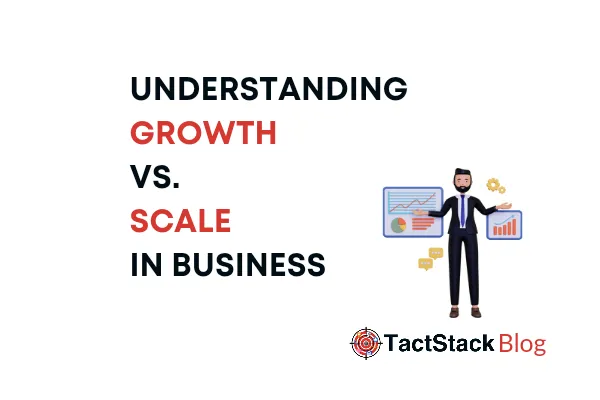TactStack Blog
All | Announcements | FAQs | Insights
TactStack Blog
All | Announcements | FAQs | Insights

Understanding Growth vs. Scale in Business: Navigating the Path to Sustainable Success
Understanding Growth vs. Scale in Business
Navigating the Path to Sustainable Success
NAVIGATING THE PATH TO SUSTAINABLE BUSINESS SUCCESS
When it comes to business, there are two phases that entrepreneurs strive for: Growth and Scale. Both of these phases can help businesses become more profitable, but they require different strategies and approaches.
Growth is all about putting more resources into the business to get more output.
This can involve hiring more employees, investing in more marketing, and expanding the product or service line. The goal is to increase revenue and customer base, even if it means sacrificing some profit in the short term.
Scale, on the other hand, is about producing more without necessarily putting in more.
This can be achieved by streamlining processes, automating tasks, and leveraging existing resources to maximize output. The goal is to increase profit margins and build a sustainable business that can operate efficiently with minimal input.
The decision to focus on Growth or Scale depends on the goals and values of the business
Growth may be ideal for a business that's just starting out and needs to establish itself in the market. It can also be useful for businesses that want to expand their reach and create a larger customer base.
However, Growth can be challenging and expensive, and it's not always sustainable.
Scale, on the other hand, is ideal for businesses that have already established themselves in the market and have a solid customer base.
By focusing on Scale, businesses can optimize their processes, cut costs, and improve profitability.
Scale is often a more sustainable and long-term approach, but it can be challenging to achieve without first focusing on Growth.
Regardless of which phase a business is in, it's important to have a clear understanding of the goals and strategies involved.
This can help entrepreneurs make better decisions about where to allocate resources and which areas to prioritize.
Both Growth and Scale can be successful strategies, but they require different approaches and priorities.
Growth requires more resources to increase output,
Scale is maximizs output with minimal input.
By understanding the differences between Growth and Scale, entrepreneurs can make informed decisions that lead to sustainable success.
Share:

Understanding Growth vs. Scale in Business: Navigating the Path to Sustainable Success
Understanding Growth vs. Scale in Business
Navigating the Path to Sustainable Success
NAVIGATING THE PATH TO SUSTAINABLE BUSINESS SUCCESS
When it comes to business, there are two phases that entrepreneurs strive for: Growth and Scale. Both of these phases can help businesses become more profitable, but they require different strategies and approaches.
Growth is all about putting more resources into the business to get more output.
This can involve hiring more employees, investing in more marketing, and expanding the product or service line. The goal is to increase revenue and customer base, even if it means sacrificing some profit in the short term.
Scale, on the other hand, is about producing more without necessarily putting in more.
This can be achieved by streamlining processes, automating tasks, and leveraging existing resources to maximize output. The goal is to increase profit margins and build a sustainable business that can operate efficiently with minimal input.
The decision to focus on Growth or Scale depends on the goals and values of the business
Growth may be ideal for a business that's just starting out and needs to establish itself in the market. It can also be useful for businesses that want to expand their reach and create a larger customer base.
However, Growth can be challenging and expensive, and it's not always sustainable.
Scale, on the other hand, is ideal for businesses that have already established themselves in the market and have a solid customer base.
By focusing on Scale, businesses can optimize their processes, cut costs, and improve profitability.
Scale is often a more sustainable and long-term approach, but it can be challenging to achieve without first focusing on Growth.
Regardless of which phase a business is in, it's important to have a clear understanding of the goals and strategies involved.
This can help entrepreneurs make better decisions about where to allocate resources and which areas to prioritize.
Both Growth and Scale can be successful strategies, but they require different approaches and priorities.
Growth requires more resources to increase output,
Scale is maximizs output with minimal input.
By understanding the differences between Growth and Scale, entrepreneurs can make informed decisions that lead to sustainable success.
Share:
TactStack Blog - your go-to resource for Announcements, FAQs, and Insights from TactStack - The Tactical Tech Stack
This site, all funnels attached, and all forms, surveys, pop ups, and banners used were built (and hosted) inside TactStack





